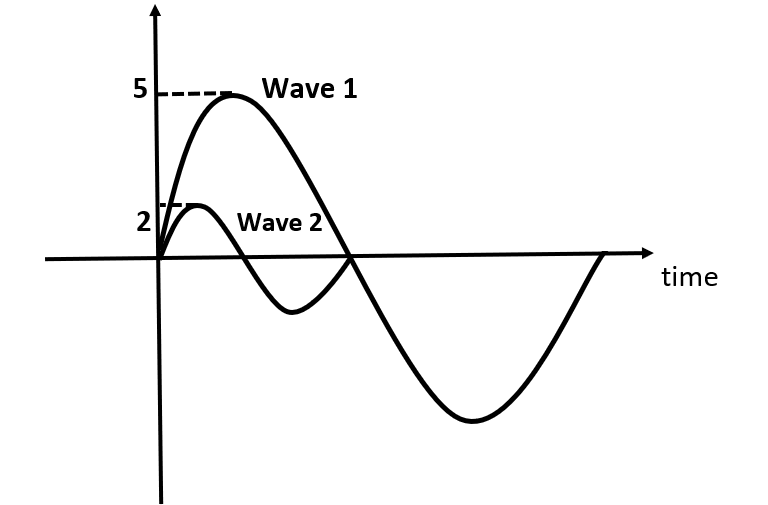
Two waves in the same medium are represented by


Answer
443.4k+ views
Hint: We have the graphical representation of two waves. From the graph, we can determine the Amplitude of the two sinusoidal waves. Once the amplitude of these waves are known, we can calculate the ratio of intensities of the two waves. This can be calculated using the fact that the intensity of any wave is proportional to the square of its amplitude. We will proceed in the above aforesaid manner.
Complete answer:
Let the amplitude of the larger wave be
Now, the relation between intensity and amplitude of a wave is given by:
Where f is the frequency of the wave.
This could be written as:
Where, k is an arbitrary constant called the constant of proportionality.
Therefore, for two waves in comparison. We can write as follows:
On rearranging terms, we get:
Putting the values of both the amplitudes in the above equation and simplifying the equation, we get:
Hence, the ratio of their average intensities of the two waves, comes out to be
Hence, option (A) is the correct option.
Note:
Here, the ratio of intensity would have been equal to the ratio of amplitude squared only, if the frequency of both the waves would have been the same. But that wasn’t the case, so we included an extra term, the angular frequency which is directly proportional to frequency into our equation to avoid mistakes. One should also be careful in writing the correct ratio in answer.
Complete answer:
Let the amplitude of the larger wave be
Now, the relation between intensity and amplitude of a wave is given by:
Where f is the frequency of the wave.
This could be written as:
Where, k is an arbitrary constant called the constant of proportionality.
Therefore, for two waves in comparison. We can write as follows:
On rearranging terms, we get:
Putting the values of both the amplitudes in the above equation and simplifying the equation, we get:
Hence, the ratio of their average intensities of the two waves, comes out to be
Hence, option (A) is the correct option.
Note:
Here, the ratio of intensity would have been equal to the ratio of amplitude squared only, if the frequency of both the waves would have been the same. But that wasn’t the case, so we included an extra term, the angular frequency which is directly proportional to frequency into our equation to avoid mistakes. One should also be careful in writing the correct ratio in answer.
Recently Updated Pages
Master Class 9 General Knowledge: Engaging Questions & Answers for Success

Master Class 9 English: Engaging Questions & Answers for Success

Master Class 9 Science: Engaging Questions & Answers for Success

Master Class 9 Social Science: Engaging Questions & Answers for Success

Master Class 9 Maths: Engaging Questions & Answers for Success

Class 9 Question and Answer - Your Ultimate Solutions Guide

Trending doubts
State and prove Bernoullis theorem class 11 physics CBSE

Who built the Grand Trunk Road AChandragupta Maurya class 11 social science CBSE

1 ton equals to A 100 kg B 1000 kg C 10 kg D 10000 class 11 physics CBSE

State the laws of reflection of light

One Metric ton is equal to kg A 10000 B 1000 C 100 class 11 physics CBSE

Difference Between Prokaryotic Cells and Eukaryotic Cells




